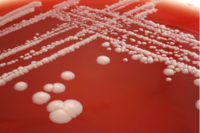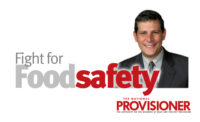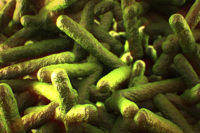Editor’s Note: This story originally published in Food Safety News. It has been edited for style and size. The National Provisioner and Food Safety News have partnered this year to bring you an even greater amount of valuable content via our 2014 Food Safety Report. To read more Food Safety News content, visit www.foodsafetynews.com.
At the end of 2013, Consumer Reports made national headlines by reporting that 97 percent of retail chicken breasts were contaminated with some form of gut bacteria. Granted, not all of those bacteria are likely to make consumers sick, but the report did find potentially harmful Salmonella on 11 percent of the samples.
The story resonated especially well with readers who expressed frustration over the recent multi-state Foster Farms Salmonella outbreaks, which had together sickened more than 550 people and hospitalized nearly 200 in the latter half of 2013. In a similar survey funded by Food Safety News publisher Marler Clark in 2011, a microbiology laboratory found Salmonella on 19 out of 100 raw chicken samples purchased from grocery stores in the Seattle area.
The recent findings have prompted many in the food industry to discuss strategies for mitigating Salmonella on chicken. Some have begun searching for examples in the European Union, where some countries have reported marked reductions in contamination levels since declaring a “zero tolerance” policy on Salmonella on chicken.
One proponent of a European-style zero-tolerance policy is Dr. Urvashi Rangan, toxicologist and executive director of the Consumer Reports Food Safety and Sustainability Center, who spoke with Food Safety News after the release of the Consumer Reports survey.
According to Rangan, Europe’s zero-tolerance policy for Salmonella on chicken has resulted in significantly lower levels of contamination in recent years, withsome estimates putting Salmonella levels below one percent in countries such as Denmark and Sweden. By comparison, while Salmonella rates on poultry in the U.S. have dropped in recent years, they are still nowhere near the one-percent benchmark across the Atlantic.
But would a zero-tolerance policy on Salmonella work in the U.S.? Some say we’ve already done it with E. coli in ground beef, while others argue that Salmonella in chicken is a completely different beast.
Proponents of a zero-tolerance policy cite the example of the U.S. Department of Agriculture’s decades-old zero-tolerance policy of E. coli O157:H7 in ground beef, which prompted largely successful efforts to curb contamination rates. Others, including some microbiologists and USDA officials, argue that zero-tolerance cannot feasibly work on the scale and cost within which the U.S. food system operates.
Like apples and oranges
More than 20 years ago, the U.S. witnessed the country’s first great foodborne illness outbreak when, in 1993, hundreds of people fell ill and four children died after eating Jack in the Box hamburgers contaminated with E. coli. A year later, the USDA’s Food Safety and Inspection Service (FSIS) declared E. coli an adulterant in ground beef, making it illegal to sell food contaminated with the bacteria.
In contrast, raw meat cannot be recalled or held from commerce for containing Salmonella. Some consumer-advocacy groups are trying to change that, having petitioned USDA to begin considering some forms of Salmonella as adulterants.
Though the U.S. beef industry first challenged the USDA’s classification of E. coli as an adulterant, beef producers have since taken to the challenge of eradicating E. coli from beef supplies, seeing significant reductions in outbreaks and recalls in recent years. That progress is largely thanks to the government first mandating E. coli’s adulteration status, said Chris Waldrop, director of the Food Policy Institute at the Consumer Federation of America.
“I think declaring Salmonella an adulterant makes life easier for FSIS,” Waldrop said. “Making that sort of declaration provides them with an easier path to keeping contaminated food off the market instead of having to take an indirect route to address problems at plants.”
But declaring Salmonella an adulterant in chicken and effectively implementing a zero-tolerance policy is just not feasible on the scale at which the U.S. poultry industry operates, said Michael Doyle, microbiologist and director of the Center for Food Safety at the University of Georgia.
Comparing E. coli in beef to Salmonella in chicken — or even European poultry industries to the U.S. industry — is like comparing apples and oranges, said Doyle, whose research focuses on reducing the prevalence of pathogens carried on meat and poultry. Doyle is also on the science advisory board for Foster Farms.
Even the methods of measuring Salmonella prevalence cannot be trusted as equivalent between countries, he added. Doyle agreed that at least some European countries likely had lower rates of Salmonella contamination on chicken, “but using the right methods, you’d likely find Salmonella in their products as well.”
And that’s not to consider the difference in scale between the industries in a European country and the U.S., he said.
“The Scandinavian countries probably produce as much chicken in a year as we do in a week in Augusta, Georgia,” Doyle said. And pound-for-pound, chicken in countries that report less than a one-percent contamination rate often costs three to five times that of U.S. chicken meat, he said.
Eliminate, or simply reduce?
In wanting to reduce Salmonella contamination rates, Doyle said that some food-safety advocates have altered the goal of “zero tolerance” from reduction to complete elimination, which he said just isn’t possible on raw chicken meat. The U.S. does, however, have a zero-tolerance policy for visible fecal contamination of chicken carcasses prior to entering the chiller at the processing facility.
In 2010, Doyle was part of a group of scientists from 16 countries who joined together to examine the scientific validity of zero-tolerance policies toward Salmonella on chicken. That group included scientists from Denmark, Sweden and the Netherlands, as well as Asia, South America and New Zealand.
In a report, the group concluded, “there is neither an effective means of eliminating Salmonella from raw poultry nor any practical method for verifying its absence.”
Instead, the group recommended risk assessments and performance objectives linked to human health outcomes. In other words, it recommended setting goals of lowering contamination by removing risks, but ultimately accepting that Salmonella will never completely go away.
“You’re not going to be able to eliminate Salmonella from raw poultry,” Doyle told Food Safety News. Ultimately, the biggest factors still come down to scale and cost. The U.S. simply produces chicken at too high of a volume to completely avoid Salmonella and still keep costs affordable, Doyle said. And the bottom line may determine it all.
“It’s virtually impossible to have zero Salmonella, according to the large-scale production conditions used here in the U.S., which help keep the price of poultry down,” Doyle said. “If you want chicken with no Salmonella, it’s going to cost a lot more money to produce.”




Report Abusive Comment